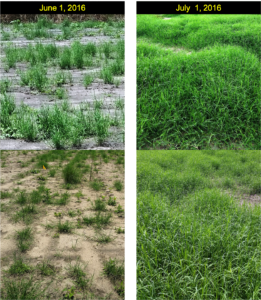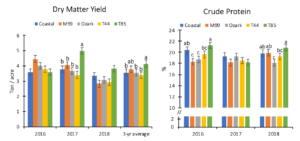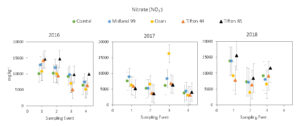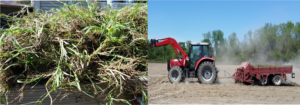Research Brief: Evaluation of Sprigged Bermudagrass Cultivars in Spray Fields
go.ncsu.edu/readext?758107
en Español / em Português
El inglés es el idioma de control de esta página. En la medida en que haya algún conflicto entre la traducción al inglés y la traducción, el inglés prevalece.
Al hacer clic en el enlace de traducción se activa un servicio de traducción gratuito para convertir la página al español. Al igual que con cualquier traducción por Internet, la conversión no es sensible al contexto y puede que no traduzca el texto en su significado original. NC State Extension no garantiza la exactitud del texto traducido. Por favor, tenga en cuenta que algunas aplicaciones y/o servicios pueden no funcionar como se espera cuando se traducen.
Português
Inglês é o idioma de controle desta página. Na medida que haja algum conflito entre o texto original em Inglês e a tradução, o Inglês prevalece.
Ao clicar no link de tradução, um serviço gratuito de tradução será ativado para converter a página para o Português. Como em qualquer tradução pela internet, a conversão não é sensivel ao contexto e pode não ocorrer a tradução para o significado orginal. O serviço de Extensão da Carolina do Norte (NC State Extension) não garante a exatidão do texto traduzido. Por favor, observe que algumas funções ou serviços podem não funcionar como esperado após a tradução.
English
English is the controlling language of this page. To the extent there is any conflict between the English text and the translation, English controls.
Clicking on the translation link activates a free translation service to convert the page to Spanish. As with any Internet translation, the conversion is not context-sensitive and may not translate the text to its original meaning. NC State Extension does not guarantee the accuracy of the translated text. Please note that some applications and/or services may not function as expected when translated.
Collapse ▲There are several vegetatively propagated bermudagrass cultivars readily available to producers in North Carolina; a.k.a., sprigged bermudagrass cultivars. We frequently get asked which is the best sprigged bermudagrass cultivar. Desirable characteristics for selecting a bermudagrass cultivar to be grown in spray fields and to be fed to livestock include: high dry matter yield and nutrient removal, rapid establishment, high nutritive value, and low tissue nitrate concentration. In light of increasing reports of bermudagrass damage by stem maggots, a cultivar that can be less susceptible to stem maggot damage is also desirable.
On-farm trial
The Forage & Grassland Program at NC State University teamed up with Livestock Extension Agents from Bladen, Cumberland,Robeson, Scotland, and Sampson Counties, and with two farmer cooperators, to establish an on-farm replicated research trial to evaluate five sprigged bermudagrass cultivars in spray field conditions. In 2016, five sprigged bermudagrass cultivars (Coastal’, ‘Midland 99’, ‘Ozark’, ‘Tifton 44’, and ‘Tifton 85’) were established on a swine farm spray field in Bladen County and were evaluated for 3 years (2016, 2017, and 2018). The field was sprigged on April 6, 2016 (Figure 1). Sprigged bermudagrass cultivars were planted at a rate of 40 bushels/acre and sprigs were planted at 3 inches depth. Plot size was 70 x 100 feet, there were a total of 15 plots with treatments (cultivars) arranged in a complete randomized block design replicated 3 times.
One week after planting, on April 13, and before bermudagrass emergence was observed, Direx (diuron) herbicide was applied at 1.3 quarts/acre; then, on June 4th, 0.625 ounces/acre of Cimarron (metsulfuron) and 2 pints/acre of 2,4-d were applied for broadleaf weed control. Since the trial was conducted on-farm in a hog farm, fertilizer was provided through hog lagoon effluent which was applied based on the farm’s waste utilization plan limits and considering weather and lagoon conditions. Harvest intervals ranged from 26 to 45 days; a walk-behind sickle bar mower was used to clip the plots to 3-4 inches stubble height. The clippings were hand-raked, weighed fresh in the field, and grab samples were collected for determination of moisture concentration, dry matter yield, nutrient analysis, and botanical composition.
Results
Under the spray field conditions of this experiment, 3 months after planting (by July 2016) ground coverage by the grasses ranged from 40 to 98% and canopy heights were equal to or greater than 14 inches; however, by August of the same year all grasses reached 100% canopy cover (Figure 2).

Figure 2. Picture of two experimental units on July 1 and June 1 during the year of establishment (2016) for bermudagrass cultivars ‘Coastal’, ‘Midland 99’ (M99), ‘Ozark’, ‘Tifton 44’ (T44), and ‘Tifton 85’ (T85) grown in spray fields in Tar Heel, NC (34°44’42.9″N; 78°49’30.4″).
The 3-year average results indicate that cultivar Tifton 85 had a slightly greater dry matter yield compared to Coastal, Ozark, and Tifton 44, and similar dry matter yield to Midland 99 (Figure 3). There were differences in dry matter yield per year and they are also attributed to observed stem maggot damage which was less for Tifton 85 and Midland 99 in years 2016 and 2017 (data not shown). The total digestible nutrient concentration (TDN) was similar among cultivars at 62.2%. There were moderate differences in crude protein (CP) concentration (ranged from 18 to 21%); however, both TDN and CP concentration are high enough to meet the nutritional demand of a lactating beef cow in the first 90 days after calving if the bermudagrass forage was the only source of feed.

Figure 3. Total seasonal dry matter yield and crude protein concentration data for bermudagrass cultivars ‘Coastal’, ‘Midland 99’ (M99), ‘Ozark’, ‘Tifton 44’ (T44), and ‘Tifton 85’ (T85) grown in spray fields in Tar Heel, NC (34°44’42.9″N; 78°49’30.4″). Bars followed by different letters within each year are statistically different.
Tissue nitrate ion concentration was examined by harvest date each year and it ranged from 3433 to 16167 mg NO3– kg-1 (0.34 to 1.62 % NO3– ) (Figure 4). Out of 55 bermudagrass hay lots harvested in this experiment, there were nine lots with NO3– concentration ≤ 5000 mg kg-1 (0.5% NO3–), seven out of those nine lots were harvested in year 2017 which had the least N loading rate per year (Table 1), and there was one hay lot in each year in 2016 and 2018.

Figure 4. Tissue nitrate ion (NO3-) concentration of five bermudagrass cultivars grown in spray fields in Tar Heel, NC (34°44’42.9″N; 78°49’30.4″). Data are means + 95% confidence interval.
Table 1. Total annual irrigation, total water inputs (precipitation + irrigation) and total N, P, and K loadings from swine effluent application.
| Year | Irrigation | Total Water Inputs | N | P | K |
| —inches — | — lbs/acre — | ||||
| 2016 | 6.5 | 67.5 | 222 | 37 | 501 |
| 2017 | 3.3 | 45.3 | 103 | 26 | 428 |
| 2018 | 5.6 | 76.4 | 276 | 52 | 842 |
The generally considered safe threshold for all kinds of livestock if forage is the sole source of feed is ≤ 5000 mg NO3– kg-1 (0.5% NO3–). Nonetheless, it is important to keep in mind that no single level of nitrate is toxic under all conditions due to the wide variation in the degree of tolerance to nitrates among animal species. Frequent testing for nitrate concentration by harvested hay lot, if possible, is advised.
Conclusions
Hay production from spray fields results in high yielding and high nutritive value forage. Differences among bermudagrass cultivars were observed for dry matter yield during years where bermudagrass stem maggot damage was observed, and in those years Midland 99 and Tifton 85 performed better. There were minor differences in terms of nutritive value estimates. Because of the high variability in nitrate ion tissue concentration, frequent testing, if possible by harvested hay lot, is advised.
Additional References
- Managing Bermudagrass Stem Maggots. UGA Extension. Bulletin 1484.
- Nitrate Toxicity. UGA Extension. Circular 915.
- Nitrate Management in Beef Cattle. North Carolina Cooperative Extension.
- The Nitrate Problem. Iowa State University, Cooperative Extension Service. Special report No. 34.



